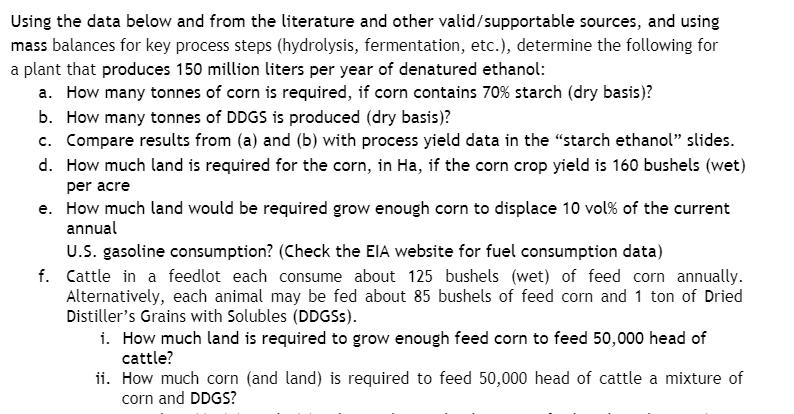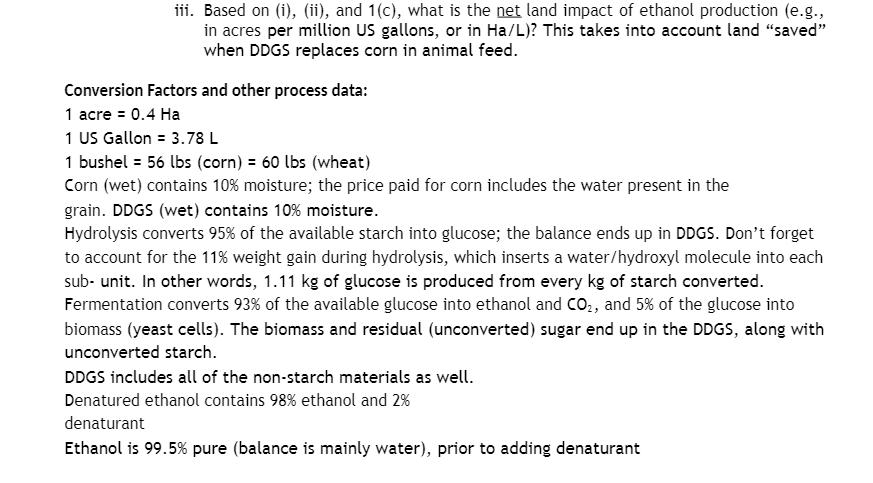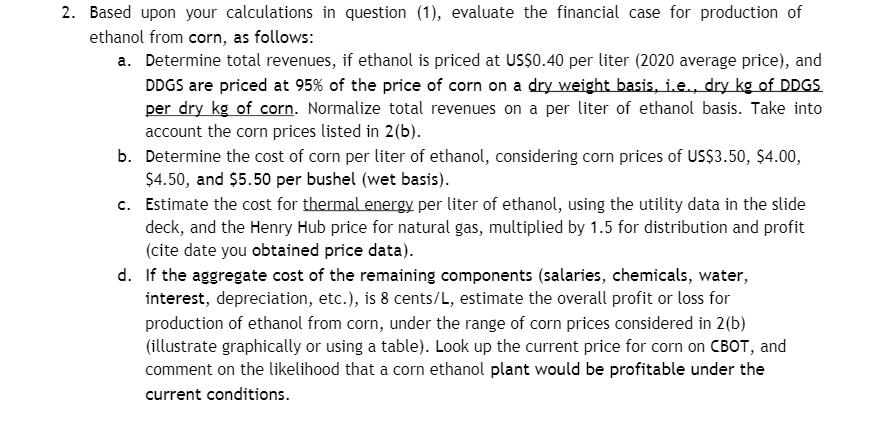Answered step by step
Verified Expert Solution
Question
1 Approved Answer
Using the data below and from the literature and other valid/supportable sources, and using mass balances for key process steps (hydrolysis, fermentation, etc.), determine



Using the data below and from the literature and other valid/supportable sources, and using mass balances for key process steps (hydrolysis, fermentation, etc.), determine the following for a plant that produces 150 million liters per year of denatured ethanol: a. How many tonnes of corn is required, if corn contains 70% starch (dry basis)? b. How many tonnes of DDGS is produced (dry basis)? c. Compare results from (a) and (b) with process yield data in the "starch ethanol" slides. d. How much land is required for the corn, in Ha, if the corn crop yield is 160 bushels (wet) per acre e. How much land would be required grow enough corn to displace 10 vol% of the current annual U.S. gasoline consumption? (Check the EIA website for fuel consumption data) f. Cattle in a feedlot each consume about 125 bushels (wet) of feed corn annually. Alternatively, each animal may be fed about 85 bushels of feed corn and 1 ton of Dried Distiller's Grains with Solubles (DDGSs). i. How much land is required to grow enough feed corn to feed 50,000 head of cattle? ii. How much corn (and land) is required to feed 50,000 head of cattle a mixture of corn and DDGS? iii. Based on (i), (ii), and 1(c), what is the net land impact of ethanol production (e.g., in acres per million US gallons, or in Ha/L)? This takes into account land "saved" when DDGS replaces corn in animal feed. Conversion Factors and other process data: 1 acre = 0.4 Ha 1 US Gallon = 3.78 L 1 bushel = 56 lbs (corn) = 60 lbs (wheat) Corn (wet) contains 10% moisture; the price paid for corn includes the water present in the grain. DDGS (wet) contains 10% moisture. Hydrolysis converts 95% of the available starch into glucose; the balance ends up in DDGS. Don't forget to account for the 11% weight gain during hydrolysis, which inserts a water/hydroxyl molecule into each sub- unit. In other words, 1.11 kg of glucose is produced from every kg of starch converted. Fermentation converts 93% of the available glucose into ethanol and CO2, and 5% of the glucose into biomass (yeast cells). The biomass and residual (unconverted) sugar end up in the DDGS, along with unconverted starch. DDGS includes all of the non-starch materials as well. Denatured ethanol contains 98% ethanol and 2% denaturant Ethanol is 99.5% pure (balance is mainly water), prior to adding denaturant 2. Based upon your calculations in question (1), evaluate the financial case for production of ethanol from corn, as follows: a. Determine total revenues, if ethanol is priced at US$0.40 per liter (2020 average price), and DDGS are priced at 95% of the price of corn on a dry weight basis, i.e., dry kg of DDGS per dry kg of corn. Normalize total revenues on a per liter of ethanol basis. Take into account the corn prices listed in 2(b). b. Determine the cost of corn per liter of ethanol, considering corn prices of US$3.50, $4.00, $4.50, and $5.50 per bushel (wet basis). c. Estimate the cost for thermal energy per liter of ethanol, using the utility data in the slide deck, and the Henry Hub price for natural gas, multiplied by 1.5 for distribution and profit (cite date you obtained price data). d. If the aggregate cost of the remaining components (salaries, chemicals, water, interest, depreciation, etc.), is 8 cents/L, estimate the overall profit or loss for production of ethanol from corn, under the range of corn prices considered in 2(b) (illustrate graphically or using a table). Look up the current price for corn on CBOT, and comment on the likelihood that a corn ethanol plant would be profitable under the current conditions.
Step by Step Solution
★★★★★
3.46 Rating (156 Votes )
There are 3 Steps involved in it
Step: 1
1a Corn required 150 million L ethanol per year Ethanol is 995 pure so 150 million L ethanol requires 1515 million L of 995 ethanol Fermentation conve...
Get Instant Access to Expert-Tailored Solutions
See step-by-step solutions with expert insights and AI powered tools for academic success
Step: 2

Step: 3

Ace Your Homework with AI
Get the answers you need in no time with our AI-driven, step-by-step assistance
Get Started


